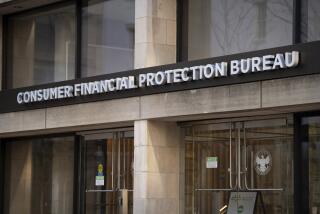Plan to forgive debt is rejected
- Share via
WASHINGTON — Federal bank regulators have rejected a request by banks and consumer advocates for a program to let lenders forgive huge portions of credit card debt.
The Office of the Comptroller of the Currency rejected the request for a special program that would allow as much as 40% of credit card debt to be forgiven for consumers who don’t qualify for existing repayment plans.
An unusual alliance of financial industry interests and consumer advocates, represented by the Financial Services Roundtable and the Consumer Federation of America, made the request to the Treasury Department agency Oct. 29. It demonstrated the urgency of the situation in a deepening economic crisis: consumers -- even those with strong credit records -- defaulting at high levels on their credit cards, while banks battered by the credit crisis bleed tens of billions from the losses.
An agency spokesman said the government objected to allowing banks to defer losses for several years on the forgiven debt, as would occur in accounting by lenders under the special program.
The agency “does not consider any plan that defers the timely recognition of loss as prudent, and any such proposal cannot be viewed favorably by us,” Timothy Long, senior deputy comptroller for bank supervision policy, said in a letter to the two groups made public Wednesday.
The Financial Services Roundtable, which represents more than 100 large banks, brokerage firms and insurance companies, will “continue to look for ways to help consumers in these extraordinary times,” said Scott Talbott, the group’s senior vice president.
Under the proposal, borrowers would be able to defer payment of income taxes they owe on the forgiven part of the debt until after the remainder was paid off. The lenders could wait until then to book their losses on the forgiven debt.
The two groups hoped that as many as 50,000 people struggling with credit card debt would be involved. On an individual basis, the amount of debt to be forgiven would rise according to the severity of the borrower’s financial situation, up to a maximum of 40%.
More to Read
Inside the business of entertainment
The Wide Shot brings you news, analysis and insights on everything from streaming wars to production — and what it all means for the future.
You may occasionally receive promotional content from the Los Angeles Times.










